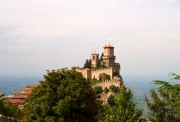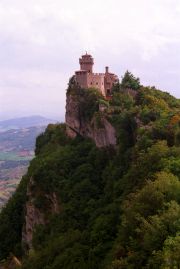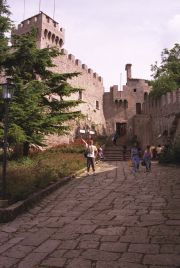It has branded itself as world's oldest republic. It respectfully ignores the Greeks and Romans, as their republics did not last. This tiny country perched on a mountain completely surrounded by Italy is truly an interesting feature of our planet.
|
 |
 |
 |
 |
 |
 |
 |
 |
One of San Marino's castles
 |
 |
San Marino was founded on 3 September 301 by Marinus of Rab, therefore long, long after the democracies of Athens, other ancient Greek and Roman cites, which expanded to the size of countries. San Marino did no expand that much. It is a small piece of land landlocked and surrounded by the state of Italy. However, it has not changed much since 301, and has retained its status of a republic for the longest period of any country on planet Earth.
Many people, including intellectuals, are not even aware of San Marino. It is not easy to spot on the map, actually. For similar reason, few people realise that San Marino's constitution dating back to 1600, might in fact be the oldest constitution in the world, predating the one of the United States of America and Poland.
For ages San Marino managed to remain sovereign, despite Italy's unification efforts, approaches of Napoleonic armies, WWI and WWII, during which the country remained neutral. Therefore it was utterly tragic that during the WWII, the Royal Air Force bombed the country on 26 June 1944 as a result of ... intelligence errors. Interestingly, at the end of WWII San Marino was the first (and probably the only and the last) country with democratically elected communist government. It lasted 12 years.
When I went to San Marino, I did not expect to see much. I was excited to see a 'different' country but I knew that travellers kept going to San Marino mainly for stamps (philatelists) and duty free shopping. So, I was pleasantly surprised to see such an historic place, complete with medieval architectures, mighty defense structures and castles, which I like so much. True, there were many, many, many, very many shops selling fragrance, tobacco and alcohol everywhere, shop assistants of which spoke many languages, as exotic as Russian, Polish, Slovak...
|
|
| Favourite spots: |
 |
 |
 |
 |
 |
 |
 |
 |
The other of San Marino's castles.
 |
 |
As great forts, fortresses and castles admirer, I would have to say that my favourite spot in the city of San Marino would be the Guaita Fortress (the First Tower) or the Cesta Fortress (the Second Tower), or both actually. The First Tower was built in the 11th century and rebuilt on several occasions since then. Some of its interior was a prison once. For this reason, perhaps, a small chapel was erected near its entrance, which was dedicated to Saint Barbara. The Second Tower, perched on the peak of Mount Titano, seems to be higher than the Guaita, was made to look more elaborate and almost as a palace. It was erected in the 13th century. Now, there is a museum of arms with exhibitions displaying war crafts from 13th - 19th centuries. Both stand on sheer hilltops. To complete the picture of the national coat of arms, the Montale Fortress (the Third Tower) is just a watchtower. There is no admission to it.
|
|
| What's really great: |
It is fascinating to see how much can actually be packed into small city in terms of interesting sights. The entire city of San Marino looks and feels like a big fortress itself, but inside one can find eye catching structures like the Palazzo Pubblico, built in the Neogothic style yet unmistakeably a Romanesque building, which was a late addition to the fabric of the city at the end of the 19th century. It has been under a great effort of restoration for many years, and I am hearing it has finally reopened to visitors. The other one that made me stop and look was the Basilica of San Marino, also built in the 19th century, on site of the former church.
I kept wandering from one tower to the other admiring the views and the strategic position of the 'rock'. It was like stepping a few centuries back in time. The steepness of some of the cobble-stoned and narrow alleys, stepped lanes, and archways added to that feeling. I could not care less about shopping!
|
|
| Sights: |
|
San Marino was added to the UNESCO World Heritage Sites in 2008. It boasts, apart from the aforementioned towers, the public palace and churches, a good number of small museums and convents and chapels. For example: Church of Saint Peter (with magic rock-hewn beds); Church of the Cappuccini (one hosting the Garibaldi's soldiers once the Republic of Rome collapsed); and the Church and Convent of Saint Francis (the oldest in the republic). The museums that are worth checking out the National Museum, based in the very intriguing Palazzo Pergami, displaying archaeological and artistic exhibits; the San Francesco Museum and Picture Gallery based in cloister dating back to the 14th century; and the Museum of Emigration and Centre for the Study of Emigration, which is based in the old Santa Chiara Monastery. There is also the Museum of Torture with over 100 of instruments designed specifically for inflicting pain and death, a blood-freezing anthology of human cruelty.
|
|
| Accommodations: |
Although Italy, which surrounds the republic, offers almost unlimited number of accommodation options, San Marino has its own hospitality base. The country offers rooms in hotels and B&Bs ranging from 1 star to 4 stars.
The cheapish 1 star options included Diamond (old city centre); Emilia (45 minutes on foot from the core historical centre); Silvana (very close to the heart of the old town).
The 2 star establishments, both in the old town (charging on average €40 for single, €55 for double, incl. breakfast) were Bellavista and La Rocca.
The more expensive ones branding itself as 4 star hotels were: Cesare (more of a business hotel, right in the old town); Grand Hotel San Marino (near the Fortresses in the upper old town); Titano (with a nice terrace restaurant); and Vintage (modern and without character).
I am not sure about availability, however if San Marino cannot accommodate you, Rimini or Ravenna on the Adriatic Coast would oblige, I am sure.
|
|
| Nightlife: |
|
In terms of nightlife, San Marino will probably not spin your head too much. It is no match for Rimini of Italy, just a few minutes away car. It seems even the residents escape their own country seeking entertainment, cinema, theatre, casinos... Unless, one looks for a romantic candle-lit dinner in a historic setting or with a spectacular view extending over the hills up to the horizon. As there is plenty of that. See below for restaurants and dining.
|
|
| Hangouts: |
|
On the way up to the Fortresses, I spotted a few great places to stop and admire the spectacular views. Not all passages were equipped with benches, but one could rest on the walls surrounding the city. On the top, between the Second and the First Towers, there was a small park, which gave shade and have a few benches for resting. It was a great area just to sit down, look up towards the fortresses or have you own caricature made by one of the artists sitting by the walls. I did that. I have to say that I enjoyed being a subject. I think the artist has treated me by medieval terms and made me look much better than I am in reality. He was very kind. I am not sure that I cared for that annoying fly that he drew entering my ear, but the rest looked professional, so I decided to reward him with the amount he requested. The entire sitting lasted under 10 minutes, and the 'portrait' now decorates one of the rooms of my parents' house...
|
|
| Restaurants: |
 |
 |
 |
 |
 |
 |
 |
 |
At the entrance to one of the castles.
 |
 |
The country has long, long tradition of catering. They are promoted by the republic's Consorzio Terra di San Marino, who from time to time organise a Gastronomic Week of San Marino, which effectively is a packaged visit to the country enriched with culinary experiences.
For centuries, if not millennia, the country specilalised in cereal, alfalfa, wine, olive oil and honey. But managed to raise livestock for milk and meat.
Today, restaurants of San Marino would keep up with the traditions, and the starters would typically include: tagliatelle, strozzapreti, ravioli, cappelletti, passatelli. Then, the main course would come with the roast meats, dishes with fragrance of milk and cheese, good rustic bread, piadina, extra-virgin olive oil, accompanied by red wines, Brugneto and Tessano aged in massive cherrywood barrels or in small oak barriques, or even the less popular white wines of Biancale and Roncale. To finish, the eatery would traditionally offer: bustrengo, caciatello, ciambella.
|
|
| Other recommendations: |
The Republic of San Marino's production of stamps and coins is known (if this would be the only thing the country is known at all) throughout the world, which attracts visitors in its own right, and provides a significant proportion of the government earning. The philatelists flock to this tiny country to acquire unique collections of stamps, which can only be used as postage inside the republic - not very useful then...
Similarly for coins. San Marino is the only site on the territory of 'larger' Italy to issue the world famous 'Scudo', the gold coin which is still legal tender. San Marino, however does not have own money, and instead uses the euro. Based on agreement with the EU, of which San Marino is not part, the republic can mint its national side of the euro coins. Since there is such a small quantity of them, they are snatched by the collectors. The National Stamp and Coin Office of San Marino sells collections and provides all necessary information and valuation.
|
|
Published on Sunday May 24th, 2009
|
|
 Publish on Facebook
Publish on Facebook
|
Sat, May 30 2009 - 10:07 PM
 by bootlegga
| Sounds like my kind of place! Thanks for a great report! |
Mon, May 25 2009 - 02:06 AM
 by jacko1 by jacko1
| This is an excellent report Krys and has certainly aroused my interest on this place, as you point out it is very little known to most people and my own personal knowledge was limited to the odd report featuring F1. Very well presented!!. |
Sun, May 24 2009 - 12:53 PM
 by pesu by pesu
And you won't show us the caricature? ;-)
A nice report about a small country full of historical details. |
| Information: |
| Login if you are a member, or sign up for a free membership to rate this report and to earn globo points! |
|
| Poland |
|
|
|
|
|
|
|
|
 |
| Portugal |
|
|
|
|
 |
| Puerto Rico |
|
|
 |
| Reunion |
|
|
 |
| Romania |
|
|
|
|
 |
| Russia |
|
|
 |
| Rwanda |
|
|
 |
| Samoa |
|
|
 |
| San Marino |
|
|
 |
| Senegal |
|
|
|

|
